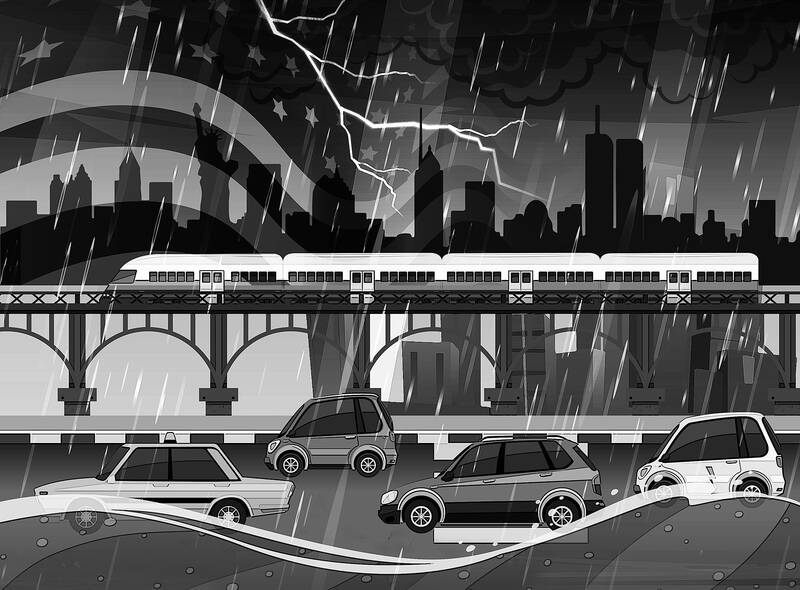New York City’s subway system is mainly known for moving millions of riders every day and scaring the US secretary of transportation. However, every so often it also becomes the world’s least-popular water park.
Instagram was rife this week with unnerving videos of subway riders watching high waters churn outside their train cars after a brief, but biblical downpour dumped more than 5.08cm of rain in less than an hour on Monday, overwhelming the city’s drains and turning subway stations into raging rivers. What might have been a mundane summer rainstorm at one time led to flooding that killed at least two people, destroyed property and snarled travel across three states.
It has becoming a grimly familiar story. In just the past two weeks, destructive and deadly flooding has occurred in Maryland, Virginia, North Carolina, Chicago, Iowa, Tampa, New Mexico and, of course, Texas.

Illustration: Louise Ting
Floods are not new, climate change deniers in my inbox said, but their frequency and severity have worsened, as the planet has become hotter. It is just physics: Warmer air can hold more water. So when those mundane summer rainstorms hit, they are wetter, dumping more rain all at once.
Hundred and even thousand-year floods become almost routine. They are even repeatedly hitting places such as Vermont, which were once considered safe havens from climate change.
In fact, this sort of flash flooding might just be the new normal, if you can use such a term to describe the phase we are experiencing as we transition to a future normal of even worse disasters after even more warming. Unfortunately, despite the obvious frequency of such events, most of the US is still not ready for it.
Two years ago, after yet another New York subway flood, I complained it was too easy for rain to bring the city to its knees. That has not improved significantly in the interim, although New York Mayor Eric Adams has invested US$1.2 billion in flood-resilient infrastructure such as storm water management and flood sensors — much of which is still being installed.
The tragedy in Texas exposed how many places are not equipped to warn people about rising waters in time to save lives. At this point, every place where it rains is potentially at risk of flooding — meaning pretty much everywhere in the world, including Death Valley.
People need to be aware of their flood risks and keep an eye on the weather, just in case their local authorities are not able to warn them.
Far more Americans also need flood insurance. Although 99 percent of US counties have experienced flooding in the past 30 years, only 4 percent of US homes are covered for floods, the US Federal Emergency Management Agency (FEMA) said.
People lacking coverage in places such as the North Carolina mountains after Hurricane Helene and Texas Hill Country on July 4 lost everything when their homes were washed away in an instant.
However, typical homeowners’ insurance policies do not include floods, and high-risk properties cannot always get separate flood coverage from private carriers. For them, it is only available through the National Flood Insurance Program (NFIP), which is managed by FEMA, which is managed by basically nobody.
FEMA director David Richardson has been invisible during the Texas floods and has expressed befuddlement about things such as the need for hurricane season planning and how big Texas is.
Richardson’s boss, US Homeland Security Secretary Kristi Noem, has joined her boss, US President Donald Trump, in openly daydreaming about killing the agency. She fired call center contractors responding to Texas flood victims and has slowed disaster response by requiring her personal sign-off on large purchases.
Trump, Noem and businessman Elon Musk’s Department of Government Efficiency laid off 1,000 FEMA staffers ahead of hurricane season. They also ended FEMA’s Building Resilient Infrastructure and Communities program, which helped places such as New York and Texas brace for future floods.
This is the opposite of how we should be moving in an era of supercharged rainstorms.
First, we need to stop burning fossil fuels as quickly as we can. The hotter the planet gets, the worse these storms would get.
Meanwhile, houses and offices need to be waterproofed along with our infrastructure. Many drainage systems were designed and built for a climate that no longer exists. They need to be upgraded to handle bigger water flows.
The NFIP might survive Trump and Noem, but it needs to be overhauled and drastically expanded to include millions more homes than are on FEMA’s limited flood zone maps.
Flash floods would always be terrifying, and it seems they are here to stay. However, there is plenty we can do to make sure they are not nearly so dangerous and destructive. When it is flooding basically everywhere, politics should not stand in the way.
Mark Gongloff is a Bloomberg Opinion editor and columnist covering climate change. He previously worked for Fortune.com, the Huffington Post and the Wall Street Journal.
The government and local industries breathed a sigh of relief after Shin Kong Life Insurance Co last week said it would relinquish surface rights for two plots in Taipei’s Beitou District (北投) to Nvidia Corp. The US chip-design giant’s plan to expand its local presence will be crucial for Taiwan to safeguard its core role in the global artificial intelligence (AI) ecosystem and to advance the nation’s AI development. The land in dispute is owned by the Taipei City Government, which in 2021 sold the rights to develop and use the two plots of land, codenamed T17 and T18, to the
Taiwan’s first case of African swine fever (ASF) was confirmed on Tuesday evening at a hog farm in Taichung’s Wuci District (梧棲), trigging nationwide emergency measures and stripping Taiwan of its status as the only Asian country free of classical swine fever, ASF and foot-and-mouth disease, a certification it received on May 29. The government on Wednesday set up a Central Emergency Operations Center in Taichung and instituted an immediate five-day ban on transporting and slaughtering hogs, and on feeding pigs kitchen waste. The ban was later extended to 15 days, to account for the incubation period of the virus
Art and cultural events are key for a city’s cultivation of soft power and international image, and how politicians engage with them often defines their success. Representative to Austria Liu Suan-yung’s (劉玄詠) conducting performance and Taichung Mayor Lu Shiow-yen’s (盧秀燕) show of drumming and the Tainan Jazz Festival demonstrate different outcomes when politics meet culture. While a thoughtful and professional engagement can heighten an event’s status and cultural value, indulging in political theater runs the risk of undermining trust and its reception. During a National Day reception celebration in Austria on Oct. 8, Liu, who was formerly director of the

The ceasefire in the Middle East is a rare cause for celebration in that war-torn region. Hamas has released all of the living hostages it captured on Oct. 7, 2023, regular combat operations have ceased, and Israel has drawn closer to its Arab neighbors. Israel, with crucial support from the United States, has achieved all of this despite concerted efforts from the forces of darkness to prevent it. Hamas, of course, is a longtime client of Iran, which in turn is a client of China. Two years ago, when Hamas invaded Israel — killing 1,200, kidnapping 251, and brutalizing countless others